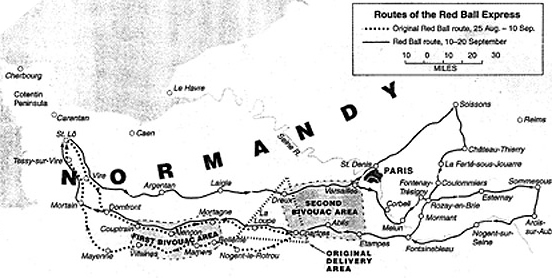Red Ball Express in 1944
Battle of Normandy
The Red Ball Express roads, from August 25 to September 20, 1944
 |
Embarkation of jerrycans in a port of Normandy in 1944. Photo: US National Archives
|
- The origins of Red Ball Express
The Red Ball Express is the nickname given by the Americans to the supply route set up between the Normandy landing beaches and the front line, first in the Cotentin Peninsula in Normandy and then in the whole of France.
 |
Jerrycans, and even milk cans, are filled with precious fuel. Photo: US National Archives |
The red ball symbol originally appeared on US Navy lodges used in the 19th century to represent a flagship. A few years later, this term refers to a train with priority content or perishable goods, moving on tracks marked with red balls. In the 20th century, American transport companies re-used the term “red ball” as their name and General Patton used one of them in 1940 during maneuvers in Texas.
 |
Fuel is the black gold of the Battle of Normandy, the priority of supplies. Photo: US National Archives
|
- Red Ball Express in Normandy
In the preparation phase of operation Overlord, the Allies are aware that victory can be achieved by the permanent supply of units to the front, with food, fuel and ammunition. The permanent bombing of Normandy, and in particular on the French railway network, handicapped the Germans during the first phase of operation Overlord. On the other hand, it is no longer possible to strengthen the allied units by train thereafter.
 |
Departure of convoys in Normandy on the Red Ball Express. Photo: US National Archives
|
The French railways are rehabilitated as the front line advances, but they can not be used at first. Pending the completion of repairs, the road remains the only supply route in the Normandy countryside. And the needs are very important: the 28 Allied divisions each need 750 tons of refueling each day, a daily total of 12,500 tons.
 |
The military police run a convoy on the Red Ball Express in Normandy. Photo: US National Archives
|
To maintain this constant war effort, a special logistical route is selected to accommodate the permanent flow of vehicles transporting supplies. Its starting point is in Saint-Lô (connected by road to Cherbourg, which has a deep water port and can accommodate large ships). The vehicles were loaded on 24 August 1944 (gathered in 67 transport companies, 132 on 29 August) and then proceeded on the road, which was rapidly dubbed “red ball express”, where they are prioritized and can not be used by civilians, down to the successive deposits of the front line.
 |
A Diamon TM20 truck and its trailer go through a ruined Norman village. Photo: US National Archives
|
 |
The broken vehicles are moved to allow convoys to continue without delay. Photo: US National Archives
|
As the battle evolved, the Germans concentrated their efforts to destroy this major logistical axis, but their aviation did not allow them to stop the continuation of supplies. More than enemy attacks, mechanical incidents are the major problems encountered on the red ball express.
 |
Rain and mud are the most common enemies of the Red Ball Express in Normandy. Photo: US National Archives
|
- Very strict instructions
The pilots, black Americans for three-quarters of them, are obliged to respect several particularly strict instructions, starting with the respect of speed limits (40 km/h) and the maintenance of the distance of 40 meters between each vehicle. Drivers must use the headlamps as a safety precaution and not just war lights. In order to ensure the progress of the progress, elements of the military police are positioned on the main crossroads of the convoys. Moreover, the structure of the bridges on these routes are reinforced by military engineering.
 |
Military police ensure that convoys are moving forward. Photo: US National Archives |
The broken trucks are ruthlessly tilted off the road to free up the way for convoys, repairs being carried out as far as possible. Every ten minutes before full hours, convoys take a break of ten minutes to allow the drivers to rest. Supply points for convoys are installed. However, several cases of voluntary sabotage were noted, carried out by the drivers themselves to obtain a few hours of rest.
 |
A mechanic carries out tire pressure monitoring during a convoy break. Photo: US National Archives
|
At the peak of its use, 5,958 vehicles travel simultaneously along this logistic axis which extends at the end of the war for nearly 450 kilometers between Saint-Lô and Soissons. Up to 12,000 tonnes of material and goods are transported daily on the red ball express.
 |
The drivers check the engine of their truck before going back to driving. Photo: US National Archives
|
The elongation created by the advance of the front is such that it creates new supply issues, notably to fuel the convoys themselves, this having the effect of temporarily slowing the progress of combat units. These incidents are quickly resolved.
 |
A US Federal truck on the Red Ball Express under the supervision of a MP. Photo: US National Archives
|

